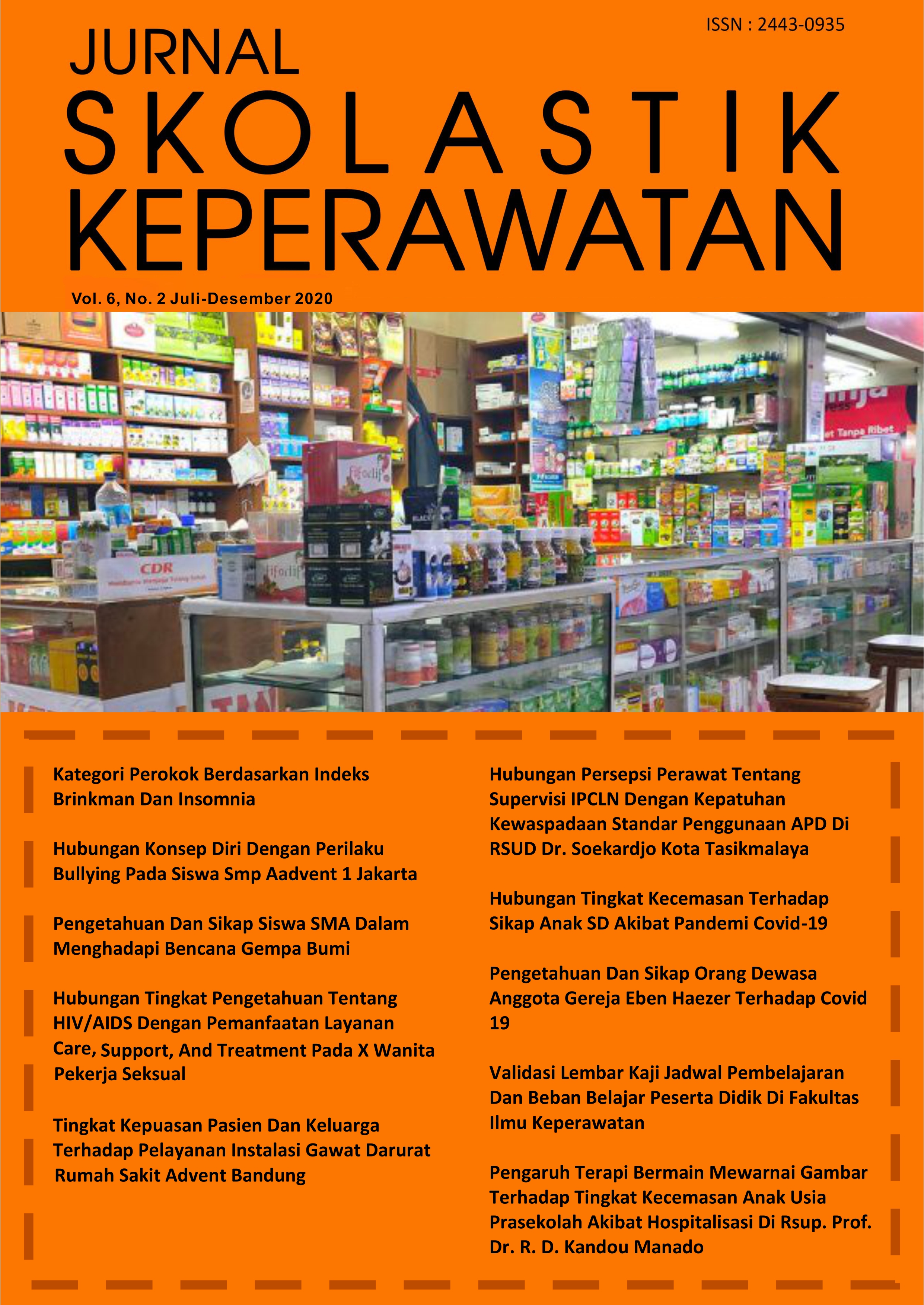HUBUNGAN PERSEPSI PERAWAT TENTANG SUPERVISI IPCLN DENGAN KEPATUHAN KEWASPADAAN STANDAR PENGGUNAAN APD DI RSUD dr. SOEKARDJO KOTA TASIKMALAYA
Kata Kunci:
Perawat, Sipervisi IPCLN, Kepatuhan StandarAbstrak
Pendahuluan: IPCLN (Infection Prevention and Control Link Nurse) sebagai pelaksana dari Program Pencegahan dan Pengendalian Infeksi (PPI) di rumah sakit diharuskan mampu melaksanakan tugasnya dalam memonitor kepatuhan perawat melakukan kewaspadaan standar. PPI penting dilaksanakan di rumah sakit dalam melindungi pasien, petugas, pengunjung, dan keluarga dari risiko tertularnya infeksi. Tujuan: Mengidentifikasi hubungan persepsi perawat pelaksana tentang supervisi IPCLN dengan kepatuhan kewaspadaan standar penggunaan Alat Pelindung Diri (APD) di RSUD dr. Soekardjo Kota Tasikmalaya. Metode: Metoda penelitian kuantitatif dengan desain deskriptif korelasi serta menggunakan pendekatan cross sectional, populasinya seluruh perawat pelaksana dari 16 ruang rawat inap dengan jumlah sampel yang diambil sebanyak 152 perawat, pengambilan data variabel persepsi perawat pelaksana tentang supervisi dengan kuesioner dan untuk kepatuhan kewaspadaan standar dengan observasi tindakan penggunaan APD. Penelitian dilaksanakan bulan Mei sampai Juni 2019 di RSUD dr. Soekardjo Kota Tasikmalaya. Analisis data hasil penelitian dengan statistik nonparametric dan uji mann whitney. Hasil: Persepi perawat pelaksana tentang supervisi IPCLN berada pada nilai rata-rata 73,11, jadi lebih dari setengahnya perawat pelaksana mempersepsikan pengawasan oleh IPCLN yang efektif. Hasil observasi berdasarkan kewaspadaan standar penggunaan APD perawat dengan nilai rata-rata 65,86%. Adanya hubungan persepsi perawat pelaksana tentang supervisi IPCLN dengan kepatuhan penggunaan APD ρ- value 0,002 < dari alpha 0,05.
Diskusi: Hasil penelitian ini menunjukkan bahwa persepsi perawat pelaksana tentang supervise yang efektif dilaksanakan akan dapat meningkatkan kepatuhan kewaspadaan standar perawat saat melakukan tindakan asuhan keperawatan. Manajemen rumah sakit perlu adanya peningkatan sosialisasi pemahaman IPCLN tentang pentingnya melakukan supervise pada perawat pelaksana saat memberikan asuhan dengan resosialisasi tugas dan fungsi IPCLN serta penerapan reward and punishment.
Unduhan
Referensi
Akib, K.M., Lebang, Y., Samudra E., et al. (2008). Pedoman Pencegahan dan Pengendalian Infeksi di Rumah Sakit dan Fasilitas Pelayanan Kesehatan Lainnya. Departemen Kesehatan R.I. Jakarta.
Anugrahini, C. (2010). Hubungan Faktor Individu Dan Organisasi Dengan Kepatuhan Perawat Dalam Menerapkan Pedoman Patient Safety di RSAB Harapan Kita Jakarta. [Tesis] Program Magister Kepemimpinan dan Manajemen Keperawatan, Fakultas Kedokteran Indonesia.
Association for Professionals in Infection Control and Epidemiology (APIC). (2015). Standar Precaution Compliance Data Collection Form.
Aty, Tyaa, Hastuti. (2014). Hubungan Persepsi Perawat Pelaksana tentang Kemampuan Supervisi Kepala Ruangan dengan Kinerja Perawat di Instalasi Rawat Inap Rumah Sakit Umum Daerah Kota Semarang. Jurnal Keperawatan FIKkeS. Vol 7 no 2
Carolina, N., & Carolina, S. (2016). National and State Healthcare Associated Infection Progres Report.
Centers for Desease Control (CDC). (2015). National and State Healthcare Associated Infection Progres Report.
Charalambous, L. (1995). Development of the Link Nurses Role in Clinical Setting. Nurse Time. Vol 91 p 36-37.
Dawson, M., Phillips, Bev., & Leggat, S.G. (2012). Effective Clinical Supervision for Regional Allied Health Professionals – the Supervisors Prespective. Australian Health Review. 91 -97.
DepKes RI. (2013). Pedoman Manajerial Pencegahan dan Pengendalian Infeksi di Rumah Sakit dan Fasilitas Pelayanan Kesehatan Lainnya. Kementerian Kesehatan dan PERDALIN Jaya. Jakarta.
Hanifah, H. (2015) Hubungan Pengawasan Kepala Ruangan dengan Tingkat Kepatuhan Perawat Menggunakan Glove pada Tindakan Injeksi di RSU Wonosari.
Ira, Mahera, Wati. (2014). Pengaruh Supervisi Klinis terhadap Penatalaksanaan Universal Precaution oleh Perawat. Jurnal Ilmu Keperawatan. Vol II No. 2. Hal 138-142
Kintan Kirgiani Kirana. (2016). Tingkat Kepatuhan terhadap Standar Operasional Prosedur pada Tindakan Penatalaksanaan Jarum Suntik Injeksi di Ruang Triase Instalasi Gawat Darurat Rumah Sakit Umum Pusat Sanglah Denpasar. Fakultas Kedokteran Universitas Udayana.
Luo, Y., He, G. P., Zhou, J. W., & Luo, Y. (2010). Factors impacting compliance with standard precautions in nursing, China. International Journal of Infectious Diseases, 14(12), e1106– e1114
Peraturan Menteri Kesehatan (PMK) no 27 tahun 2017. Tentang Pedoman Pencegahan dan Pengendalian Infeksi di Fasilitas Pelayanan Kesehatan. Jakarta : Kemenkes.
Sahara, A. (2011). Faktor-faktor yang berhubungan dengan Kepatuhan Perawat dan Bidan dalam Penerapan Kewaspdaan Standar / Kewaspadaan Universal di RS PMI Bogor. lontar.ui.
Said, Nafizullah, Fayaz., et al. (2014). Knowledge and Practice of Universal Precautions Among Health Care Workers in Four National Hospitals in Kabul Afganistan. Journal Infection Dev Ctries 4 : 535 – 542.
Simanjuntak, P. (2011). Manajemen dan Evaluasi Kinerja. Lembaga Penerbit Fakultas Ekonomi Universitas Indonesia. Jakarta.
Wahyu Rizky. (2016). Analisis Faktor-faktor yang Berhubungan dengan Kejadian Plebitis pada Pasien yang Terpasang Kateter Intravena di Ruang Bedah RS Ar Prabumulih. Jurnal Ners and Midwifery Indonesia. Vol 4 no 2. p 102-108.
Winstanley J, White E. (2012). New Evidence in the Implementation and Evaluation of Clinical Supervision. Virginia Henderson Glob Nurs e-Repository.
##submission.downloads##
Diterbitkan
Cara Mengutip
Terbitan
Bagian
Lisensi
Hak Cipta (c) 2021 Asep Rahmadiana, Hilman Mulyana

Artikel ini berlisensiCreative Commons Attribution-NonCommercial-ShareAlike 4.0 International License.
Penulis yang mempublikasikan naskahnya di jurnal ini menyetujui hal-hal berikut:
- Hak cipta tetap pada penulis, penulis memberikan kepada jurnal hak penerbitan pertama dan sekaligus melisensi karyanya mengikuti Creative Commons Attribution License yang mengizinkan orang lain untuk berbagi karya dengan penghargaan terhadap hak kepenulisan dan penerbitan pertama di jurnal ini.
- Penulis bisa mengikuti kontrak tambahan lain untuk distribusi non-ekslusif bagi karyanya tersebut (contoh: mempostingnya ke repositori institusi atau menerbitkannya dalam sebuah buku), dengan penghargaan terhadap penerbitan pertama di jurnal ini.
- Penulis diizinkan dan didorong untuk mem-posting karya mereka online (contoh: di repositori institusi atau di website mereka) sebelum dan selama proses penyerahan, karena dapat mengarahkan ke pertukaran produktif, seperti halnya sitiran yang lebih awal dan lebih banyak dari karya yang diterbitkan. (Lihat The Effect of Open Access).








